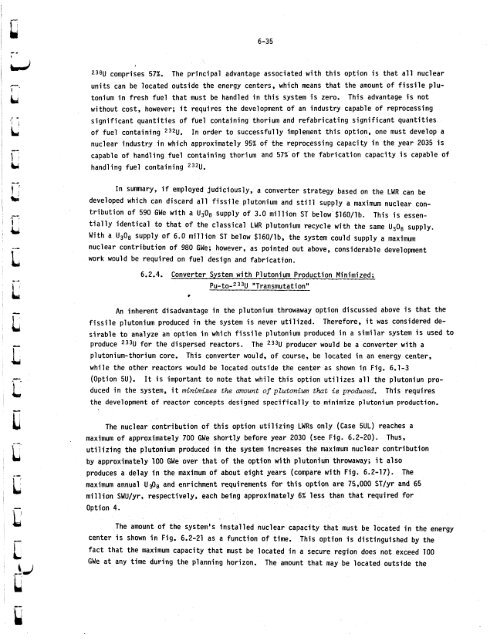ORNL-5388 - the Molten Salt Energy Technologies Web Site
ORNL-5388 - the Molten Salt Energy Technologies Web Site
ORNL-5388 - the Molten Salt Energy Technologies Web Site
Create successful ePaper yourself
Turn your PDF publications into a flip-book with our unique Google optimized e-Paper software.
L<br />
L<br />
L<br />
rI i<br />
t<br />
b<br />
c<br />
L<br />
h:<br />
6-35<br />
238U comprises 57%. The principal advantage associated with this option is that all nuclear<br />
units can be located outside <strong>the</strong> energy centers, which means that <strong>the</strong> amount of fissile plu-<br />
tonium in fresh fuel that must be handled in this system is zero.<br />
without cost, however; it requires <strong>the</strong> development of an industry capable of reprocessing<br />
significant quantities of fuel containing thorium and refabricating significant quantities<br />
of fuel containing 232U. In order to successfully implement this option, one must develop a<br />
nuclear industry in which approximately 95% of <strong>the</strong> reprocessing capacity in <strong>the</strong> year 2035 is<br />
capable of handling fuel containing thorium and 57% of <strong>the</strong> fabrication capacity is capable of<br />
handling fuel containing 232U.<br />
This advantage is not<br />
In sumary, if employed judiciously, a converter strategy based on <strong>the</strong> LWR can be<br />
developed which can discard all fissile plutonium and still supply a maximum nuclear con-<br />
tribution of 590 GWe with a U3O8 supply of 3.0 million ST below $160/lb. This is essentially<br />
identical to that of <strong>the</strong> classical LWR plutonium recycle with <strong>the</strong> same U308 supply.<br />
With a U308 supply of 6.0 million ST below $160/lb, <strong>the</strong> system could supply a maximum<br />
nuclear contribution of 980 GWe; however, as pointed out above, considerable development<br />
work would be required on fuel design and fabrication.<br />
6.2.4. Converter System with Plutonium Production Minimized;<br />
Pu-~o-~ 33U "Transmutation"<br />
An inherent disadvantage in <strong>the</strong> plutonium throwaway option discussed above is that <strong>the</strong><br />
fissile plutonium produced in <strong>the</strong> system is never utilized. Therefore, it was considered de-<br />
sirable to analyze an option in which fissile plutonium produced in a similar system is used to<br />
produce 233U for <strong>the</strong> dispersed reactors. The 233U producer would be a converter with a<br />
plutonium-thorium core. This converter would, of course, be located in an energy center,<br />
while <strong>the</strong> o<strong>the</strong>r reactors would be located outside <strong>the</strong> center as shown in Fig. 6.1-3<br />
(Option 5U). It is important to note that while this option utilizes all <strong>the</strong> plutoniun produced<br />
in <strong>the</strong> system, it minimizes <strong>the</strong> amount of pZutoniwn that is produced. This requires<br />
<strong>the</strong> development of reactor concepts designed specifically to minimize plutonium production.<br />
The nuclear contribution of this option utilizing LWRs only (Case 5UL) reaches a<br />
maximum of approximately 700 GWe shortly before year 2030 (see Fig. 6.2-20). Thus,<br />
utilizing <strong>the</strong> plutonium produced in <strong>the</strong> system increases <strong>the</strong> maximum nuclear contribution<br />
by approximately 100 GWe over that of <strong>the</strong> option with plutonium throwaway; it also<br />
produces a delay in <strong>the</strong> maximum of about eight years (compare with Fig. 6.2-17). The<br />
maximum annual u& and enrichment requirements for this option are 75,000 ST/yr and 65<br />
million SWUlyr, respectively, each being approximately 6% less than that required for<br />
Option 4.<br />
The amount of <strong>the</strong> system's installed nuclear capacity that must be located in <strong>the</strong> energy<br />
center is shown in Fig. 6.2-21 as a function of time. This option is distinguished by <strong>the</strong><br />
fact that <strong>the</strong> maximum capacity that must be located in a secure region does not exceed 100<br />
GWe at any time during <strong>the</strong> planning horizon. The amount that may be located outside <strong>the</strong>



![Review of Molten Salt Reactor Physics Calculations [Disc 2]](https://img.yumpu.com/21979492/1/190x247/review-of-molten-salt-reactor-physics-calculations-disc-2.jpg?quality=85)












